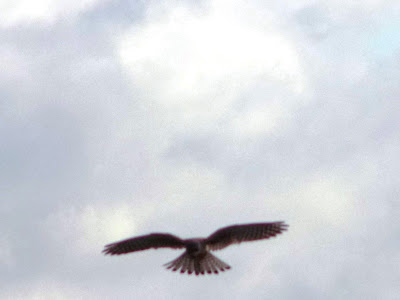The "beast from the East" brought lots of birds over from mainland Europe, especially fieldfares and redwings1.
This is one of the many redwings I've seen locally recently though sadly I've yet to spot a fieldfare. It's unlikely that many of these birds will be around for much longer as they migrate back to mainland Europe in the Spring2. Lots of birds that have spent the winter in Spain and Southern Europe will stop off in the East of the country on their way further North.
Another bird that seems to be around in higher numbers than usual this winter is the goosander.
I've tried to find evidence that this is a national trend but struggled to find much. A local Scottish newspaper recently reported that increasing numbers of goosanders were partially responsible for poor fishing on the River Tweed3, though again that seems to be anecdotal evidence rather than scientific. Numbers certainly appear to be on the up though and I like to imagine that one day in the not too distant future we might have breeding goosander locally.
A few other local spots now. Here's one of our stranger small birds, the nuthatch.
Nuthatches look a little like small woodpeckers and behave like treecreepers, walking up and down trees to find items of food in trees3. Whilst most birds migrate or at least move a little in their lifetime, nuthatches rarely move far from where they hatched. They are a bit more flexible when it comes to food than treecreepers and will feed on the ground and come to feeders when they need supplement their diet.
I also saw a green woodpecker up a tree recently.
You might imagine that this is where you would expect to see a woodpecker but this species is more often seen on the ground where they feed for ants4. Green woodpeckers have much weaker bills than other species and therefore peck wood much less often. They don't drum to communicate like other species and rarely feed on trees, only doing so at times of low food5- which I suspect might be the case at the moment. It's also possible that they are beginning to excavate nest holes.
Whilst I am still deeply sad about the new housing estate which is shooting up on former farmland at the moment I am finding it interesting to see how the local wildlife is adapting to it. There are long metal fences along the perimeter of the site and I've previously seen buzzards using it as a perch- this weekend I saw a kestrel doing the same.
These fences, just over human head height, are really useful for kestrels. Whilst they often hunt using their famous hover technique, they also jump down at prey from low perches. There is, at the moment at least, long grass directly below this fence which is perfect for rodents. I watched as the kestrel leapt down from it's perch though it didn't seem to be successful on that attempt.
Here's another kestrel from a few weeks ago which was hovering in order to hunt.
Finally, here's a few more photos from the last of the snow and the last week.
 |
| A Feral Pigeon looking rather confused by the pile of snow atop the bird table. |
 |
| Water dripping down from the eaves created these icicles on a bush under our living room window |
 |
| Robin in the snow |
 |
| Dunnock |
 |
| The Avon Roe Deer reliably in their usual spot. |
 |
| This Grey Heron was hunting amongst the high grasses on the flood plain. It looks like it may have damaged a wing but i was too far away to be able to see clearly. |
That's all for today but I'll be back at the weekend with the Nature News for March.










No comments:
Post a Comment